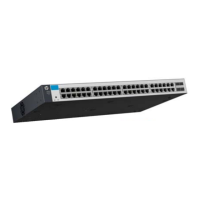
Do you have a question about the HP 1810-48G and is the answer not in the manual?
| Form Factor | Rack-mountable |
|---|---|
| Switching Capacity | 104 Gbps |
| VLAN Support | Yes |
| Forwarding Rate | 77.3 Mpps |
| MAC Address Table Size | 16, 000 entries |
| Jumbo Frame Support | Yes |
| Operating Temperature | 0°C to 40°C |
| Management | Web-based management |
| Dimensions | 440 x 210 x 44 mm |
| Features | Energy Efficient Ethernet, QoS |
| Power Consumption | Maximum 42 W |
| Operating Humidity | 10% to 90% (non-condensing) |
Verify the documentation kit, switch, accessory kit, and AC power cord are included.
Review safety precautions to avoid personal injury or product damage.
Connect the AC power cord; the switch powers on automatically.
Confirm Power LED is On and Fault LED is Off after the self-test completes.
Attach brackets using M4 screws, then secure to rack with 12-24 screws.
Attach self-adhesive pads to the bottom corners of the switch.
Connect PC to switch with Ethernet, configure PC IP and Subnet Mask.
Note default IP address (192.168.2.10) and blank password.
Set PC IP address to 192.168.2.12 and subnet mask to 255.255.255.0.
Open web browser and navigate to http://192.168.2.10.
Configure IP network settings via Network Setup > Get Connected.
Save settings via Maintenance > Save Configuration to retain after reboot.
Use only genuine HP mini-GBIC/SFP transceivers and Laser Class 1 SFPs.
Supported SFPs can be hot-swapped; disconnect cables first.
Ensure switch port and connected device speed/duplex settings match.
Secure rack/cabinet; mount heaviest devices at the bottom.
Mount with network ports up/down; avoid mounting with ventilation facing up/down.
Use grounded, adequately sized power cords; avoid overloading circuits.
Ensure ambient temperature is within specification and airflow is not restricted.
